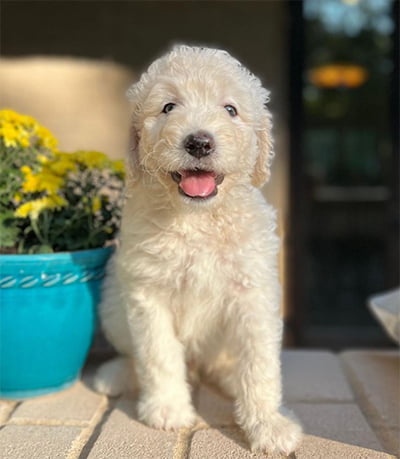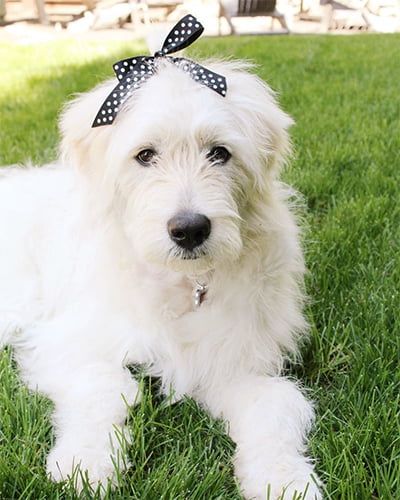Looking for a giant dog companion but wanting something that is gentle and sweet? Maybe you want a protector for the house or kids but need a dog who's still lovable and friendly? The Pyredoodle might just be the dog for you.
A mix between Great Pyrenees and a standard Poodle, this gentle giant is a beloved hybrid dog breed for being a protector and an incredibly sensitive and careful puppy at heart. Not to mention, it is a low-shedding breed!
So is a Pyredoodle designer dog for you? Let's find out.
Breed Characteristics
Temperament | Gentle, loyal |
Intelligence | Moderate |
Affection/Friendliness | Very affectionate |
Trainability | Moderate |
Moderate | |
Exercise Needs | Moderate to high |
Apartment Living | Can adapt |
Family Friendly | Yes |
Pet Friendly | Yes |
Drooling Level | Low |
Energy Level | Moderate to high |
Loneliness Tolerance | Moderate |
Adaptability | Moderate to high |
Tendency to bark | Moderate |
Origin
The origin of the Pyredoodle, like many poodle mixes, began in the 1980s with the rise in popularity of partially hypoallergenic designer dogs. Pyredoodles may have existed earlier as natural mutts, but they really began to be purposefully bred by the 2000s, most likely in the United States, as hypoallergenic companion dogs.
Pyredoodles are the hybrid of a Standard Poodle and a Great Pyrenees. They are also known as the Great Pyrenees Poodle, Pyreneespoo, Pyrepoo, and Pyreneesdoodle.
Pyredoodles are not a breed recognized by the American Kennel Club (AKC) as there is not yet a standard for the breed regarding appearance and temperament. This does not mean, however, that you won't have any idea of what kind of dog you are getting. Most Pyredoodles will be some variation of their poodle parent and Great Pyrenees parent, though how much of each largely depends on lineage.

Breed Overview
Height: 22-26"
Weight: 85-95 lbs
Height: 28-32"
Weight: 90-100 lbs
Breed Group
Hybrid
Life Span
10-12 years
Coat
Thick and wavy
Coat Length
Medium-high
Hypoallergenic
Yes
Shedding Level
Low
Size
The Pyredoodle is a large breed of dog with adult dogs that can reach heights of 22-32 inches and weigh 85-100 pounds. The more Great Pyrenees in the hybrid's bloodline, the bigger the Pyredoodle will be.
Personality
Pyredoodles have great personalities. Being a mix of two intelligent species that are known for their loyalty and protectiveness, Pyredoodle makes a perfect dog for a family with kids and other pets.
They are friendly, loving, calm, and loyal dogs while also being protective. This makes them great family dogs, watchdogs, and protectors of small childcare or households. They are even-tempered dogs and are the very definition of a gentle giant.
Some Pyredoodles tend to be shy dogs, with proper socialization, they can gain the confidence to guard your home.
Appearance/Colors
A Pyredoodle's color and coat type will vary depending on the parentage they inherit from their parents. They could have coats colored black, white, grey, cream, or apricot. Their coats will be shorter and wavy if they lean more towards their poodle parent. A Pyredoodle leaning more towards its Great Pyrenees genes will have a straighter, thick double coat.
Temperament
Pyredoodles have very even temperaments and make great family dogs. Their protective nature makes them natural guardians of small children and other small pets. Very gentle and careful with small children and wary of strangers and make ideal watchdogs. Non-aggressive with family and are generally quiet unless they sense danger. They make good companions for moderately active families and individuals, though their size may not make them appropriate for everyone.
Diet/Nutritional Needs
As a big breed dog, a Pyredoodle needs a lot of food. However, this breed is also prone to weight gain, so it is important to measure your dog's daily food and keep treats to a minimum. You will need high-quality food designed for large dog breeds high in calcium and phosphorus to ensure your dog's bones develop well. This is particularly true for your Pyredoodle puppy.
This breed is only a medium-energy dog so if you are unsure about the current amount, always consult with your vet about the correct amount given your dog's particular size, age, and activity levels.
With this breed, you should also be careful to ensure that your Pyredoodle doesn't eat too fast, as this can easily lead to bloat. Use a slow feeder or provide smaller portions of meals.

Activity/Exercise Needs
The Pyredoodle is a smart dog and can get bored very easily. It is a fairly active dog that will not only need regular daily exercise but plenty of puzzle toys and interactive games or trick training. However, due to this breed's large size, you should be careful not to over-exercise your Pyredoodle either since this can lead to joint issues.
Plan on getting your dog out for at least thirty minutes every day, walking, jogging, or swimming. An off-leash dog park is not ideal for this dog breed since they are prone to wandering and can be aggressive towards strangers.
Additionally, be careful not to exercise your Pyredoodle dog too soon after or before feeding since this can lead to bloat. Wait an hour or two before or after feeding to exercise your Pyredoodle.
This is a breed of dog prone to weight gain and who will be lazy if not regularly engaged in an activity, so while it does not have high exercise needs, you will need to commit to a daily routine.
Grooming Needs
Like its parent breeds, the Pyredoodles have a dense coat that requires medium to low grooming needs. If your Pyredoodle inherits more Great Pyrenees traits, it may have a thick double coat. If it inherits more Poodle gene pools, it may have a dense single coat that is low shed and easier to keep neat.
Despite being a low shedding dog, you should still aim to regularly brush your Pyredoodle to prevent mats and tangles and plan to take it to the groomers every two months.
Bathing your Pyredoodle is not recommended as this can make angels and mats much worse and lead to skin issues. Regularly check your dog's nails and trim as needed. Examine ears routinely as well, checking for any signs of debris or irritation.
Adaptability
The Pyredoodle mixed breed dog is relatively adaptable and does well with children and other dogs, making it suitable for families. They can also thrive in apartment settings since they have lower exercise needs and are not overly hyper. These dogs do not tolerate the heat well, so plan ahead for hotter seasons. They thrive in cold weather, thanks to that thick Great Pyrenees coat.
Trainability of a Pyredoodle Puppy
Pyredoodles are smart, brilliant dogs that are relatively easy to train. They can be a bit stubborn, so consistency and patience are key, along with positive reinforcement. You should start training at an early age to keep any bad habits from taking root and maintain good practices throughout your dog's life. Early socialization will ensure that your puppy grows into a gentle, well-mannered dog despite their large size and tendency towards suspicion of strangers.

Life Expectancy
The life expectancy for a relatively healthy Pyredoodle is 10-12 years.
Potential Health Issues
Like most hybrid breeds, the Pyredoodle is less prone to disease than either of its purebred parents. However, the issues could be related to its parents' common illnesses and conditions, and ensuring that Pyredoodle puppies' parents are health screened can go a long way to reducing caches of hereditary conditions.
Hip Dysplasia
Hip dysplasia is the malformation of a puppy or dog's joints due primarily to genetics. While it may not bother younger dogs, it can be excruciating. Early health screenings may be able to help you assess the likelihood of hip dysplasia in your puppy.
Eye Problems
Common eyes issues Pyredoodles could suffer from include—
- Conjunctivitis
- Cataracts
- Corneal ulcers
- Glaucoma
- Progressive retinal atrophy
Bloat
Bloat is a dangerous condition that results when a dog's stomach fills with gas, extending and twisting, preventing food from entering or exiting the stomach.
Cancer
Common cancer types seen in Pyredoodles include—
- Mast cell tumors
- Lymphoma
- Melanoma
- Bone cancer
- Hemangiosarcoma
Patellar Luxation
This is a condition that is a result of a dog's kneecap moving out of place. It is a genetic condition that can lead to limb or joint pain or even eventual lameness.
Cushing's Disease
This disease occurs when the adrenal glands overproduce cortisol. This excess of cortisol puts the dog at risk of other conditions that can lead to kidney damage, diabetes, and even death.
Hypothyroidism
Hypothyroidism in canines affects the thyroid's ability to produce or regulate certain metabolism-related hormones.
